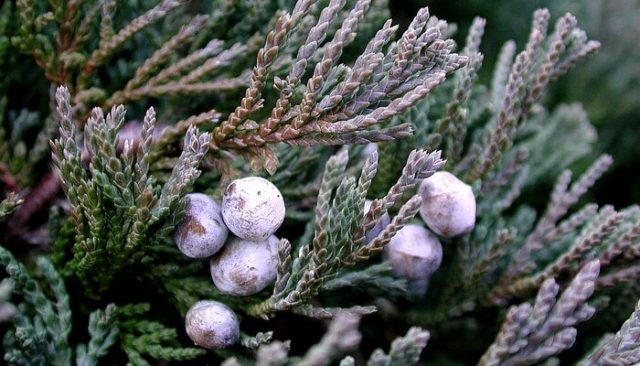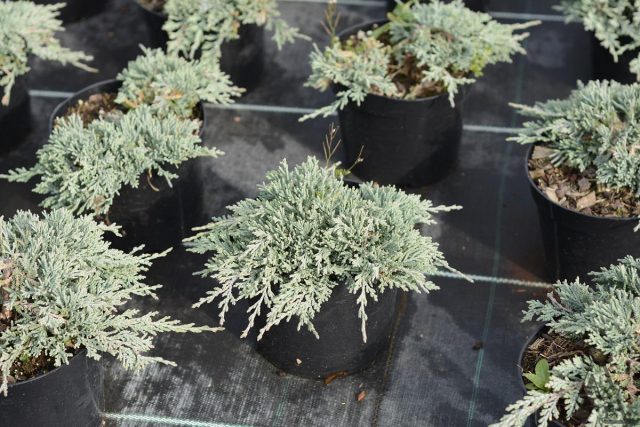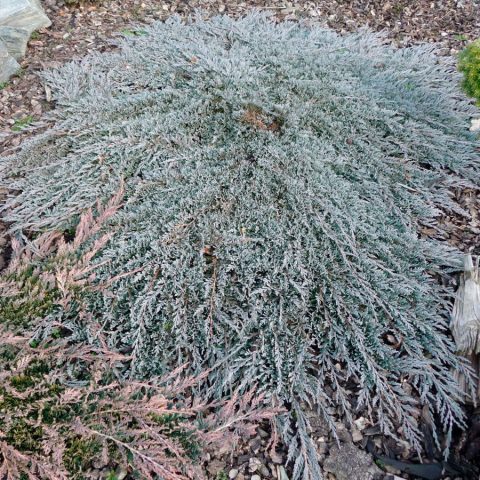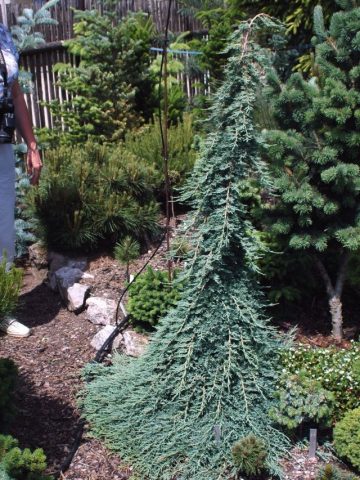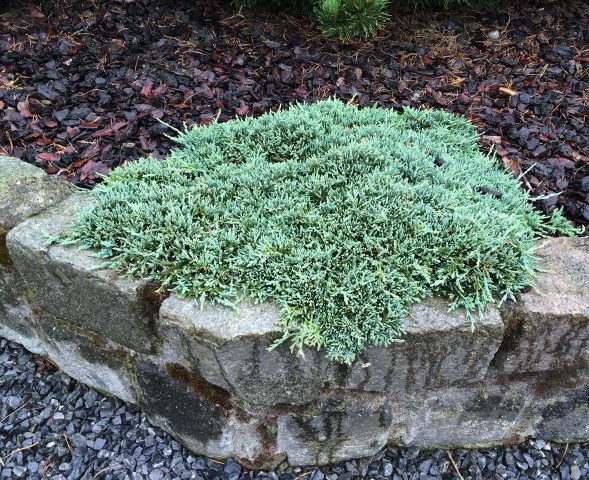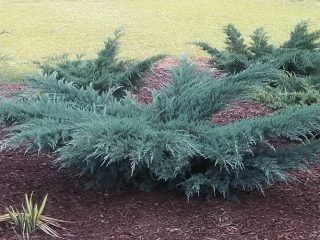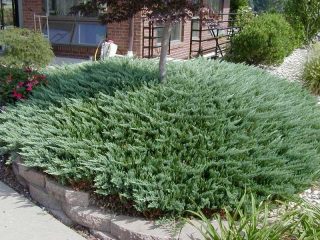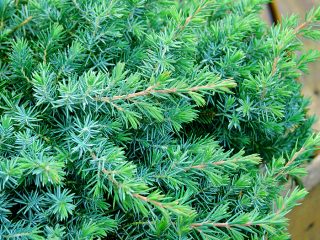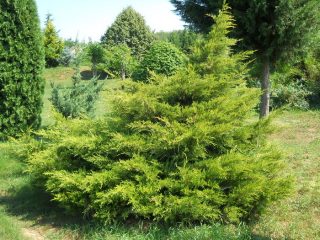Content
Ice Blue juniper is a highly decorative shrub with evergreen needles of a bluish tint, the result of selection by scientists from the United States since 1967. The variety tolerates winters well in the middle lane, is drought-resistant, sun-loving. Lovers grow creeping juniper not only horizontally, but also vertically.
Description of horizontal ice blue juniper
A dwarf slow-growing plant from the Cypress family is also found under the names Icy Blue, Monber. Creeping juniper bushes of the Ice Bluyu ground cover variety spread up to 2 m in diameter, rise slightly in height, only from 5 to 10-20 cm. Long juniper shoots are covered with brown bark of a warm shade. Flexible, soft branches of the variety, gradually spreading over the soil, create a dense carpet of a green-bluish color. Shoots grow very slowly, up to 15 cm per year, rise slightly up an oblique line. By the age of 10 years of development, the Icee Blue juniper bush reaches a height of 10 cm, spreads up to 1 m in width. Dwarf juniper seedlings at the age of 6-7 years are usually offered for sale.
The scaly cylindrical needles of the Ice Blue juniper variety slightly change color according to the seasons: in summer with a green-blue overflow, in winter it approaches a steel shade with lilac nuances. On old juniper plants, fruits are formed, small blue cones of a round shape, up to 5-7 mm in diameter, with a thick white bloom. A shrub of the Ice Blue variety adapts to the climate conditions of 4 zones of cold resistance, tolerates short-term drops in temperature to - 29-34 ° C. Juniper grows well in the Moscow region and other areas of the middle climatic zone. The variety takes root well in urban conditions, therefore it is widely used in the design of megacities and industrial zones. The Ice Blue juniper needles do not tolerate prolonged drought well, but in the middle lane they need to be planted in a place where the sun is present for almost the whole day.
The natural habitat of the plant distribution is the mountainous areas of North America, areas of the sandy coast. As a garden decor, the Icee Blue juniper variety is used in conditions close to natural:
- in rockeries;
- on the alpine slides;
- in compositions with low coniferous crops;
- as a ground cover crop of uniform color.
Planting and caring for Ice Blue juniper
A shrub of the Ice Blue variety will delight for a long time with its decorative appearance and be a picturesque element of garden compositions, if the plant is correctly placed and planted according to the requirements of agricultural technology.
Seedling and planting plot preparation
Juniper Ice Bluyu is not particularly picky about the composition of the soil, but loves moisture-permeable, well-drained areas. The variety shows the best development on moderately moist, loose sandy loam and loam, neutral or slightly acidic. For planting junipers, choose a well-lit, sunny place, you can have a light and short partial shade. Under trees or in the shade of buildings, the needles of this variety lose their picturesqueness, become dull. Low-lying wet places, like heavy soils, are unfavorable for the Ice Bluu shrub. Stunted shrubs can suffer from snow drifts, so these areas are also best avoided.
Typically, this juniper plant is purchased from nurseries, where the seedlings are kept in containers. Such bushes are moved at any time of the warm season, but preferably in early spring, as soon as the soil allows work to be carried out. Ice Blue juniper with an open root system is planted later, although there is a danger that the needles will burn if they are not covered with a shading net. In those areas where the frosts are early, during autumn planting, the variety may not have time to take root. Open roots are strengthened with a growth stimulator according to the instructions, kept in water for 6-10 hours. The plant in the container is watered abundantly so that the earthy clod easily comes out of the container without destruction.
Landing rules
According to the description, the Icee Blue juniper takes up a lot of space over time, so the holes are dug at large intervals, up to 1.5-2 m.Algorithm for planting the Ice Blue variety:
- the size of the planting pit is twice or three times the volume of the seedling capacity;
- depth - 0.7 m;
- drainage is placed on the bottom with a layer of 20-22 cm;
- a seedling is placed on a substrate of peat, sand and garden soil in a ratio of 2: 1: 1 and sprinkled with earth so that the root collar remains above the surface of the hole;
- water and mulch;
- within a week, the seedling is watered in 1-2 days with 5-7 liters of water.
Watering and feeding
Water the creeping juniper Icee Blue in the trunk circle, 10-30 liters 1-2 times a month. In a hot summer without precipitation, watering is increased and sprinkling is carried out in the evening every week. In the near-trunk circle in late autumn and early spring, they put top dressing from humus, compost or peat. Pine bark and sawdust, citric acid, garden sulfur are used to acidify the soil. In mid-spring, the variety is supported with complex fertilizers:
- "Kemira";
- nitroammofosk and others.
Mulching and loosening
The area near the trunk circle is regularly loosened after watering. Weeds 1.5-2 m around the juniper bush are removed, because pathogens of fungal diseases and pests can multiply on them. For mulch, waste from the processing of coniferous trees is used, and in the fall, compost, humus, peat.
Trimming and shaping
The densely spread Ice Blue juniper, as in the photo, does not require pruning. To create a more lush crown in the form of a carpet, the tops of the shoots are pinched in the spring or early summer. In March, April, after the snow melts, they look at how the bush overwintered, remove the damaged, broken shoots. Ice Blue juniper has an interesting shape on the trunk. The tree is created using special methods in nurseries. The care of such a tree includes a shaping haircut, which is carried out by specialists.
Sometimes the branches of an adult plant of the Icee Blue variety give a spectacular appearance of a waterfall.
Preparing for winter
With the first frosts, young bushes are covered with spruce branches or the remains of wilted plants and sprinkled with peat, a layer up to 12 cm high. You can also cover the top with agrofibre instead of spruce branches. The shelter protects from frost and bright sunlight in late winter, early spring, from which the needles can burn out. So that the needles do not warm up during winter thaws, they save mulch from large fragments of bark under the paws of a creeping variety in the fall. In early spring, with the melting of the snow, they remove its mass from the juniper bush.
Reproduction
The creeping Icee Blue variety is easy to propagate by layering: the shoot is laid in a groove, pinned to the soil, having removed the mulch from the ground, and covered with earth. During the season, several shoots take root, which are planted in a year. When propagating by cuttings, last year's shoot is chosen, extending from an old branch, which is located in the middle of the bush:
- the lignified heel of a 12-16-centimeter cutting is kept in a growth stimulator according to the instructions;
- placed in a moist peat and sand substrate;
- a mini greenhouse made of film is installed on top;
- the substrate is regularly slightly moistened, and the cuttings are sprayed;
- after 40-47 days rooting occurs, the greenhouse is removed.
The sprouts are planted in a school, which is carefully covered for the winter.
Diseases and pests of juniper horizontal Icee Blue
The variety can suffer from fungal diseases of the needles or bark cancer. For prophylaxis, branches are not injured, patients are removed. Having found signs of fungi, the bush is treated with fungicides:
- Ridomil Gold;
- Quadris;
- Horus;
- Ordan or others.
Against pests - scale insects, aphids, moths, insecticides are used:
- Match;
- Actellik;
- Engio;
- Aktara.
Conclusion
Juniper Ice Blue, undemanding to the soil, frost-resistant and drought-resistant, cover for the winter only in the first years, the care is minimal. If you follow all the requirements for transplanting, a creeping bush with bluish-green needles will develop well. The plant will decorate any garden plot with its original look.

